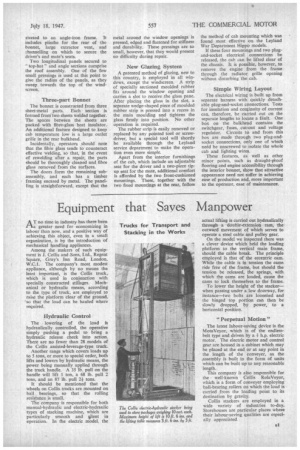Equipment that Saves Manpower
Page 35

If you've noticed an error in this article please click here to report it so we can fix it.
Trucks for Transport and Stacking in the Works
AT no time in industry has there been a greater need for economizing in labour than now, and a positive way of achieving this object, even in a small organization, is by the introduction of mechanical handling appliances.
Among the makers of such equipment is J. Collis and Sons, Ltd., Regent Square, Gray's Inn Road, London, W.C.1. The company's most modest appliance, although by no means the least important, is the Collis truck, which is used in conjunction with specially constructed stillages. Mechanical or hydraulic means, according to the type of truck, are employed to raise the platform clear of the ground, so that the load can be hauled where required.
Hydraulic Control
The lowering of the load is hydraulically controlled, the operative simply pushing a pedal to bring a hydraulic release check into action. There are no fewer than 28 models of the Collis assisted-leverage-type truck.
Another range which covers loads up to 5 tons, or more to special order, both lifts and lowers by hydraulic means, the power being manually applied through the truck handle. A 35 lb. pull on the handle will lift 1 ton, a 68 lb. pull 2 tons, and an 87 lb. pull 24 tons.
It should be mentioned that the wheels on Collis trucks are mounted on ball bearings, so that the rolling resistance is small.
The company is responsible for both manual-hydraulic and electric-hydraulic types of stacking machine, which are particularly smooth and jlent in operation. In the electric model, the actual lifting is carried out hydraulically through a double-extension ram, the outward movement of which serves to operate a steel cable and pulley gear.
On the model we inspected there was a clever device which held the loading platform to the vertical main frame, should the cable break. The principle employed is that of the eccentric cam. While the cable is in tension the cams ride free of the frame, but should the tension be released, the springs, with which the cams are loaded, cause the cams to lock themselves to the frame.
To lower the height of the stacker— when passing under a low doorway, for instance—two bolts are loosened and the hinged top portion can then be slowly dropped, by power, to a horizontal position.
"Perpetual Motion"
The latest labour-saving device is the MotaVeyor, which is of the endlessbelt type and driven by a Ih.p. electric motor. The electric motor and control gear are housed in a cabinet which may be placed at the end or at any point in the length of the conveyer, as the ,assembly is built in the form of units which can be built up to any reasonable length.
This company is also responsible for the well-known Collis RolaVeyor, which is a form of conveyer employing ball-bearing rollers on which the load is carried from the loading point to its destination by gravity.
Collis stackers are employed in a wide variety of industries to-day. Storehouses are particular places where their labour-saving qualities are especially appreciated.




















































































